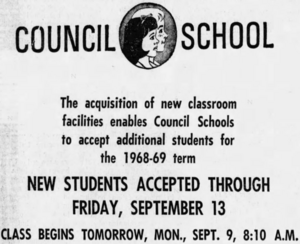Education segregation in the Mississippi Red Clay region facts for kids
The Mississippi Red Clay region in Mississippi was a place where schools were kept separate for different races. This was called education segregation. Before 1954, Mississippi had rules that let schools stay segregated. After a big court case called Brown v. Board of Education, the state still tried to keep schools separate, but often through private schools. Over time, government help for these private schools became less and less. In Jackson, the state capital, some public schools even became private schools just for white students, run by groups called Citizens' Councils. Today, some private schools in this area are still mostly or all white. They are a reminder of that time.
Contents
What is the Mississippi Red Clay Region?
The Red Clay region is a part of Mississippi. It's in the middle of the northern half of the state. Big cities like Jackson and Meridian are in this area. Most people in the counties of the Red Clay region are white. This is different from the Mississippi Delta region to the west, where most people are African American.
Before the Brown v. Board of Education ruling, African American children in the Delta region didn't have to go to school, and it wasn't always free. Because of this, many didn't attend. For example, in one county, over 20,000 African American children were school-aged, but less than 8,000 were actually in school. Many black children worked in farming, especially during the cotton harvest. Also, schools were often too far away to walk to, and school buses were not always provided. Money was also a problem. In 1949-50, one county spent the same amount of money on white schools (for 28% of the population) as it did on black schools (for 72% of the population). Parents of black children were sometimes asked to pay for heating their schoolhouses. So, for many African American children, Brown wasn't just about going to school with white kids; it was about being able to go to school at all.
How Schools Stayed Separate After Brown
The Brown v. Board of Education decision in 1954 said that separate schools were illegal. But Mississippi mostly ignored this rule. Before Brown, the state had a "freedom of choice" policy. This policy let students choose which school to attend, but it often kept schools segregated.
In the 1960s, when lawsuits forced schools to integrate, white parents started their own private schools. These were called segregation academies. The number of students in private schools in Mississippi grew a lot, from 5,000 to 40,000, between 1969 and 1971.
Mississippi was slow to follow the Brown ruling. Other states, like Virginia, started making new laws and private schools earlier. Mississippi's first segregation academies didn't open until 1967. By then, courts were already saying that state money for segregated private schools was illegal.
In 1969, a court ruled that Mississippi's grants to private schools, which were mostly segregation academies, were against the law. This case was called Coffey v. State Educational Finance Commission.
Later in 1969, the Supreme Court made another important decision in Alexander v. Holmes County Board of Education. The Court said Mississippi could not take "all deliberate speed" to integrate. Instead, schools had to become "unitary," meaning fully integrated, right away. After this, many white parents in the Red Clay region started private schools for their children.
Council Schools in Jackson

Most segregation academies were started by local groups. But in Jackson, a group called the Citizens' Councils created a whole system of twelve schools. Some of these schools included:
- Council School No 1 Hartfield
- Council School No 2 McCluer (later merged into Hillcrest Christian School)
- Council School No 3 (later Woodland Hills Academy)
- Council School No 4 Plantation
- Council School No 5 Central Hinds
- Council School No 6 Magnolia
- Council School No 7 Hanging Moss
The Citizens' Council group was very good at getting support from the state government. Out of 42 segregation academies that received state money, eight were in Jackson. A writer named Hodding Carter III said the Mississippi Citizens' Council was "the biggest, most tightly organized, the most powerful" one. Because of these private schools, the number of white students in Jackson's public schools dropped from 21,000 to less than 9,000.
These Council schools offered good education. They taught subjects like Latin, business law, and data processing.
Schools Today
Today, public schools in Mississippi are integrated. The last federal lawsuit about school segregation in the state was settled in 2017. Private schools in Mississippi are mostly overseen by the Mississippi Association of Independent Schools. They don't get much help from the state government. Only private schools that are officially approved can get state aid, like schoolbooks. None of these independent schools are approved by the state.
In Jackson, all the old Council schools are now closed. However, a private school called Jackson Academy had less than ten percent black students in 2014–2015. This is in a city where about 69% of the people are African American.
In Meridian, Lamar Academy is a private school with less than five percent black students. The city of Meridian is about 62% African American. The public schools in Meridian have faced challenges. In 2012, the city was part of a court case that pointed out problems in its public school system.
Further north in the Red Clay region, Calhoun Academy is a private school where all the students are white.

